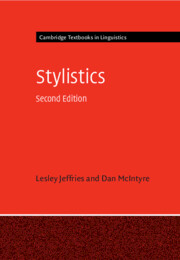Refine search
Actions for selected content:
168 results
3 - Ulysses
-
-
- Book:
- The Cambridge Companion to James Joyce
- Published online:
- 14 August 2025
- Print publication:
- 21 August 2025, pp 47-63
-
- Chapter
- Export citation
18 - Television and the Janus Face of Chinese Hip-Hop
- from Part IV - Contexts for Rap
-
-
- Book:
- The Cambridge Companion to Global Rap
- Published online:
- 25 July 2025
- Print publication:
- 14 August 2025, pp 261-272
-
- Chapter
- Export citation
5 - How to Do Translating
-
- Book:
- Introducing Translation
- Published online:
- 29 April 2025
- Print publication:
- 22 May 2025, pp 110-131
-
- Chapter
- Export citation
Chapter 3 - Individuals, Networks, Communities, Society: From Variation to Change
-
- Book:
- English Sociolinguistics
- Published online:
- 01 May 2025
- Print publication:
- 15 May 2025, pp 52-83
-
- Chapter
- Export citation
II - The Authors of the Red Book
-
- Book:
- Tolkien and the Mystery of Literary Creation
- Published online:
- 17 April 2025
- Print publication:
- 08 May 2025, pp 84-148
-
- Chapter
- Export citation
Chapter 26 - Correspondence
- from Part III - Writings
-
-
- Book:
- Percy Shelley in Context
- Published online:
- 17 April 2025
- Print publication:
- 24 April 2025, pp 196-202
-
- Chapter
- Export citation

Stylistics
-
- Published online:
- 18 February 2025
- Print publication:
- 09 January 2025
-
- Textbook
- Export citation
Chapter 25 - Dictionaries and Editors
- from Part IV - Dictionaries and Domains of Use
-
-
- Book:
- The Cambridge Handbook of the Dictionary
- Published online:
- 19 October 2024
- Print publication:
- 31 October 2024, pp 493-511
-
- Chapter
- Export citation
12 - Style
- from Part II - Forms of the Poem
-
-
- Book:
- The Cambridge Companion to the Poem
- Published online:
- 30 May 2024
- Print publication:
- 06 June 2024, pp 196-210
-
- Chapter
- Export citation
3 - The Tricks of the Writing Trade
-
- Book:
- Compelling Communication
- Published online:
- 30 May 2024
- Print publication:
- 30 May 2024, pp 67-92
-
- Chapter
- Export citation
18 - Finding Your Voice
- from Part IV - Building a Career
-
-
- Book:
- The Cambridge Companion to Composition
- Published online:
- 25 May 2024
- Print publication:
- 30 May 2024, pp 291-300
-
- Chapter
- Export citation
Part III - Styles, Conventions, and Issues
-
- Book:
- The Cambridge Companion to Composition
- Published online:
- 25 May 2024
- Print publication:
- 30 May 2024, pp 175-284
-
- Chapter
- Export citation
Chapter 15 - Style and Language
- from Part III - Literary Background
-
-
- Book:
- Jonathan Swift in Context
- Published online:
- 02 May 2024
- Print publication:
- 09 May 2024, pp 116-122
-
- Chapter
- Export citation
8 - Ecce Mann
-
-
- Book:
- Nietzsche and Literary Studies
- Published online:
- 03 May 2024
- Print publication:
- 25 April 2024, pp 186-209
-
- Chapter
- Export citation
1 - Heraclitus’ Clarity
-
-
- Book:
- Nietzsche and Literary Studies
- Published online:
- 03 May 2024
- Print publication:
- 25 April 2024, pp 16-36
-
- Chapter
- Export citation
24 - Variation in Gesture: A Sociocultural Linguistic Perspective
- from Part V - Gestures in Relation to Interaction
-
-
- Book:
- The Cambridge Handbook of Gesture Studies
- Published online:
- 01 May 2024
- Print publication:
- 18 April 2024, pp 616-640
-
- Chapter
- Export citation
1 - Why Signs?
- from Part I - General Characteristics
-
- Book:
- Chinese Signs
- Published online:
- 29 February 2024
- Print publication:
- 07 March 2024, pp 3-9
-
- Chapter
- Export citation
Possessive pronouns in Welsh: Stylistic variation and the acquisition of sociolinguistic competence – Corrigendum
-
- Journal:
- Language Variation and Change / Volume 36 / Issue 1 / March 2024
- Published online by Cambridge University Press:
- 06 March 2024, p. 121
-
- Article
-
- You have access
- Open access
- HTML
- Export citation

Chinese Signs
- An Introduction to China's Linguistic Landscape
-
- Published online:
- 29 February 2024
- Print publication:
- 07 March 2024
Possessive pronouns in Welsh: Stylistic variation and the acquisition of sociolinguistic competence
-
- Journal:
- Language Variation and Change / Volume 36 / Issue 1 / March 2024
- Published online by Cambridge University Press:
- 30 January 2024, pp. 25-48
-
- Article
-
- You have access
- Open access
- HTML
- Export citation
